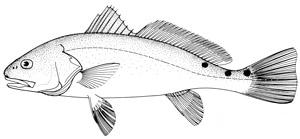
IDENTITY
Biological features
Body elongate with slightly arched back and sloping head. Primarily coppery brown or reddish, though whitish ventrally. Snout blunt with rather large, inferior mouth containing bands of villiform teeth. No barbells, which differentiates this species from closely related black drum (Pogonias cromis). Two dorsal fins, the first with ten hard spines and the second with one hard spine and multiple soft rays (24). Caudal fin slightly concave with one or more large black chromatophores above lateral line. During spawning season, males produce characteristic drumming noise by rubbing specialized muscles against air bladder.
Images gallery
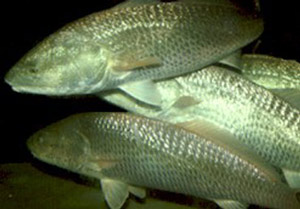 |
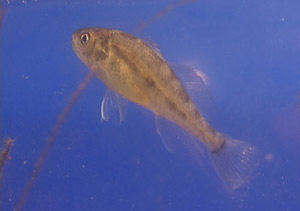 |
Sciaenops ocellatus - broodstock |
Sciaenops ocellatus - juvenile |
PROFILE
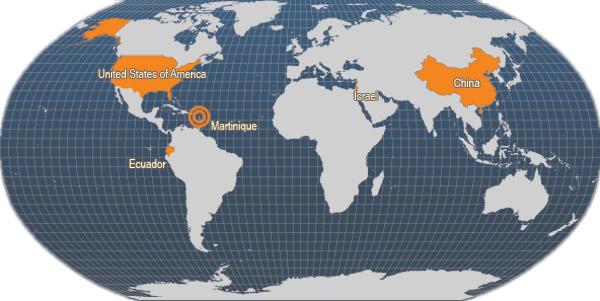
Historical background
Interest in the culture of red drum in captivity began in the late 1970s over concerns of declining natural populations due to commercial and recreational fishing activities. Since then a variety of regulatory measures were implemented (e.g. size and bag limits) and commercial fishing has been eliminated entirely in many areas. Initial aquaculture methods were developed in the United States of America, particularly in Texas and Florida, in order to provide alternatives to wild-caught fish and for stock enhancement efforts. With the development of reliable culture techniques, the commercial production of this species has expanded to other countries because red drum is a popular food fish, relatively hardy and adapts well to aquaculture conditions.
Main producer countries

Main producer countries of Sciaenops ocellatus (FAO Fishery statistics, 2006)
Habitat and biology
The red drum is a euryhaline fish distributed along the Atlantic and Gulf of Mexico coasts from Cape Cod, Massachusetts to Tuxpan, Mexico. Adults spawn from August through October in coastal waters frequently near tidal inlets. Red drum spawn pelagic eggs (approximately 1.0 mm diameter), with large females producing >1 million eggs. Larvae (approximately 6-8 mm SL) are transported into estuaries via currents where they settle into seagrass meadows. Juveniles and sub-adults typically remain in bays and estuaries moving offshore once they are 3.5-5 years old to join the adult spawning population.
PRODUCTION
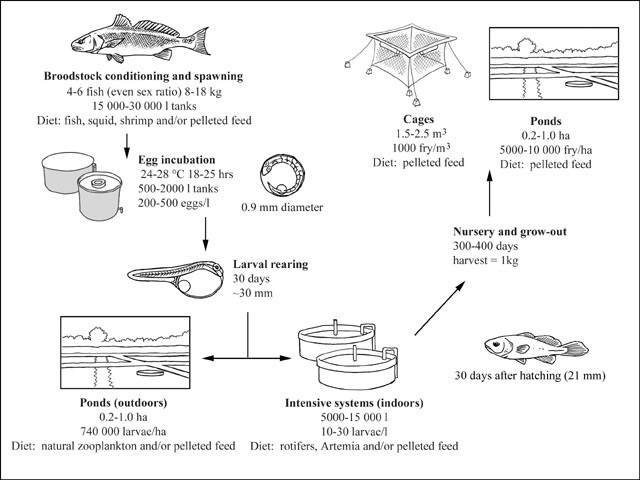
Broodstock
In some cases, eggs and/or fry are purchased from established hatcheries as an alternative to maintaining and spawning broodstock. However, red drum adapt well to captivity and many producers maintain broodstock to ensure a constant supply of larvae for grow-out. Adults can be maintained in circular fibreglass tanks (10 to 17 m3, 1.5 m high) that are connected to an external filter box. Four to six fish may be successfully spawned in such systems using an equal sex ratio. Typically, broodstock are fed 3-5 times a week on a diet of fish, squid, shrimp and/or pelleted feeds.
In the majority of countries producing red drum, broodstock must be imported as it is not an endemic species. As a result, genetic drift is likely to occur over several years of culture with a limited number of broodstock, which may negatively affect production. In order to preserve the genetic diversity of cultured red drum adequate numbers of individuals and families should be maintained in order to minimize inbreeding.
Spawning
Techniques for year-round spawning are well established for this species. A 120 day photoperiod and temperature regime can be used for spawning red drum in captivity. Broodstock are initially acclimated to a temperature of 17 °C and a photoperiod of 9 hours light (HL) which simulates winter conditions for naturally occurring adults. Following the acclimation of the adults, temperature and photoperiod are gradually increased and subsequently decreased over a period of 120 days.
Following initial conditioning of the broodstock, controlled spawning may be achieved throughout the year by manipulations in temperature. For example, spawning may be temporarily suspended when the water temperature drops below 23 °C and resumed once the temperature is raised beyond 23 °C. Red drum usually spawn just after the lights turn off in the evening. The eggs are positively buoyant in salinities greater than 25‰. Overnight, eggs are transported to an external filter box where they are collected in a ~500 micron nitex bag.
Following removal from the egg collector, eggs are set directly into rearing tanks or initially hatched out in incubators (500-2 000 litres; 200-500 eggs/l) and subsequently transferred to the rearing tanks. Disinfection of the eggs with 50-100 ppm formalin for ~1 hr helps decrease bacterial load and fungal growth. Eggs are approximately 1 mm in diameter and hatch within 18-25 hours at temperatures of 24-28 °C.
Rearing systems are typically circular fibreglass tanks set in environmentally controlled rooms with average volumes of 5 000-15 000 litres, although first feeding larvae may also be transferred to ponds for culture. Rearing density ranges from 10-30 larvae/l and survival through the larval stage may be >50 percent. Initially, optimal temperature and salinity for hatching and larval rearing are 25-30 °C and 25-30‰, although wider ranges may be used for older larvae. For example, high survival rates have been reported at 10‰, 5‰ and 1‰ for 3 mm, 6 mm and 15 mm larvae, respectively. Larvae may be reared to ongrowing stocking size either within the hatchery or in ponds.
Intensive larval rearing
Red drum larvae are approximately 2.2 mm SL at hatching and are generally ready to feed 3 days post hatch (dph). Larvae are initially fed rotifers at concentrations of 5-10/ml 3-10 dph and subsequently fed Artemia nauplii on 11-15 dph. From this point on, larvae will readily feed on a microparticulate diet, although it is best to co-feed live prey and the inert diet during the weaning period. Alternatively, red drum can be fed a combination of rotifers and inert diet (~0.25 mm) 3-7 dph, followed by inert diet alone - gradually increasing particle size - without sacrificing growth and survival. Live prey are frequently enriched with highly unsaturated fatty acids such as arachidonic acid (ARA), eicosapentaenoic acid (EPA) and docosahexaenoic acid (DHA), which improve growth and survival. Enrichments are frequently employed to enhance the fatty acid composition of prey items including live microalgae, microalgae paste, commercial preparations and marine fish oils. The addition of microalgae to the rearing tanks (Nannochloris occulata, Isochrysis galbana) at concentrations of 40 000 - 100 000 cells/ml also enhances larval growth and survival. Once fish reach the juvenile stage (less than 1 month), they may be relocated to ponds or net cages for grow-out.
Ponds of 0.2-1.0 ha in size are generally filled 5-10 days prior to stocking. Inorganic and organic fertilizers are added to the ponds in order to initiate a phytoplankton bloom that in turn establishes a zooplankton community, primarily consisting of copepods. Larvae (2 dph; 740 000/ha) are moved from the hatchery into ponds once zooplankton levels reach a density of approximately 250 organisms/l. Fish are maintained in these systems through 30 dph (~30 mm SL) and subsequently moved into larger ponds or net cages.
Red drum are ongrown in cages or ponds.
Pond culture
In the late 1980s and early 1990s pond culture of red drum in the United States of America was severely affected by the low temperatures encountered during the winter months, which resulted in substantial mortalities. The lower lethal temperature for red drum juveniles is thought to be 8-10 °C, although the expected value depends on salinity and the rate of decline in temperature. In order to combat losses due to low temperatures, culturists have modified production practices. For instance, fish are brought indoors at a weight of approximately 1 g, where they are held in semi-closed recirculating systems, and returned to outdoor ponds (150-225 g) once water temperatures increase. Fingerlings are fairly cannibalistic; frequent grading of the fish while indoors helps to decrease mortality rates, thereby increasing overall production. Market-sized fish (~1 kg) from such systems may be achieved within 11 months.
Cage culture
A variety of cage sizes and types are used for the cage culture of marine finfish. In China, cages are constructed of flexible mesh bags attached to solid frames and are 1.5-2.5 m3 in size. Red drum fingerlings (0.2 g) are stocked at 1 000 fry/m3. As the fish grow, they may be moved into larger cages and the density decreased to ~400 fry/m3. Cannibalism is a frequent problem and the fish are therefore regularly graded to decrease overall mortality. Market size (~1 kg) is normally reached within one year.
Fingerlings grow well on a variety of commercially available feeds formulated specifically for red drum or for other warm water marine species. The nutritional requirements are fairly well understood. Red drum juveniles require a diet containing 35-45 percent protein for maximum growth. Dietary protein is primarily provided by fish meal, although soybean meal may be substituted as long as at least 10 percent of the crude protein is provided by fish meal. As noted above for larvae, juveniles require dietary HUFAs; an inclusion of n-3 HUFAs at ~10 percent of the dietary lipid is recommended. There is limited specific information available regarding the vitamin and mineral requirements of this species; these ingredients are generally added to the diet via commercially available premixes that have been developed for the culture of other fish species. Practical diets for red drum usually contain 40 percent crude protein, 5-7 percent fish oil, <7 percent crude fibre, together with vitamin and mineral premixes.
Red drum may be harvested from ponds by seine. Multiple harvests from one pond using a grading seine that captures fish of certain sizes results in higher overall production. Alternatively, ponds may be drained and the fish collected in a holding basin from which they are more easily captured. Red drum may be harvested from cages with the use of dip nets following concentration of the fish by slightly raising one side of the bottom net or otherwise lifting the net out of the water.
Red drum need careful handling during all stages of culture as well as during harvesting and processing to maintain the nutritional and aesthetic value of the fish, and to avoid contamination. All equipment used to handle or process the fish should be well maintained and thoroughly cleaned before, during and after processing. Local authorities responsible for overseeing the handling and processing of seafood should be contacted for detailed information regarding the sanitary processing of fish.
The following analysis of the production costs associated with operating a red drum aquaculture facility in the United States of America, using ponds for the grow-out of fingerlings from 0.4 g to 1 kg over a time frame of approximately one year, were reported in 1994. Although the reported cost estimations may no longer be valid due to inflation, etc., the factors used to determine the estimates and their relative importance are still relevant today.
Production cycle

Production cycle of Sciaenops ocellatus
Production systems
Seed supply
Broodstock
In some cases, eggs and/or fry are purchased from established hatcheries as an alternative to maintaining and spawning broodstock. However, red drum adapt well to captivity and many producers maintain broodstock to ensure a constant supply of larvae for grow-out. Adults can be maintained in circular fibreglass tanks (10 to 17 m3, 1.5 m high) that are connected to an external filter box. Four to six fish may be successfully spawned in such systems using an equal sex ratio. Typically, broodstock are fed 3-5 times a week on a diet of fish, squid, shrimp and/or pelleted feeds.
In the majority of countries producing red drum, broodstock must be imported as it is not an endemic species. As a result, genetic drift is likely to occur over several years of culture with a limited number of broodstock, which may negatively affect production. In order to preserve the genetic diversity of cultured red drum adequate numbers of individuals and families should be maintained in order to minimize inbreeding.
Spawning
Techniques for year-round spawning are well established for this species. A 120 day photoperiod and temperature regime can be used for spawning red drum in captivity. Broodstock are initially acclimated to a temperature of 17 °C and a photoperiod of 9 hours light (HL) which simulates winter conditions for naturally occurring adults. Following the acclimation of the adults, temperature and photoperiod are gradually increased and subsequently decreased over a period of 120 days.
Following initial conditioning of the broodstock, controlled spawning may be achieved throughout the year by manipulations in temperature. For example, spawning may be temporarily suspended when the water temperature drops below 23 °C and resumed once the temperature is raised beyond 23 °C. Red drum usually spawn just after the lights turn off in the evening. The eggs are positively buoyant in salinities greater than 25‰. Overnight, eggs are transported to an external filter box where they are collected in a ~500 micron nitex bag.
Following removal from the egg collector, eggs are set directly into rearing tanks or initially hatched out in incubators (500-2 000 litres; 200-500 eggs/l) and subsequently transferred to the rearing tanks. Disinfection of the eggs with 50-100 ppm formalin for ~1 hr helps decrease bacterial load and fungal growth. Eggs are approximately 1 mm in diameter and hatch within 18-25 hours at temperatures of 24-28 °C.
Hatchery production
Rearing systems are typically circular fibreglass tanks set in environmentally controlled rooms with average volumes of 5 000-15 000 litres, although first feeding larvae may also be transferred to ponds for culture. Rearing density ranges from 10-30 larvae/l and survival through the larval stage may be >50 percent. Initially, optimal temperature and salinity for hatching and larval rearing are 25-30 °C and 25-30‰, although wider ranges may be used for older larvae. For example, high survival rates have been reported at 10‰, 5‰ and 1‰ for 3 mm, 6 mm and 15 mm larvae, respectively. Larvae may be reared to ongrowing stocking size either within the hatchery or in ponds.
Intensive larval rearing
Red drum larvae are approximately 2.2 mm SL at hatching and are generally ready to feed 3 days post hatch (dph). Larvae are initially fed rotifers at concentrations of 5-10/ml 3-10 dph and subsequently fed Artemia nauplii on 11-15 dph. From this point on, larvae will readily feed on a microparticulate diet, although it is best to co-feed live prey and the inert diet during the weaning period. Alternatively, red drum can be fed a combination of rotifers and inert diet (~0.25 mm) 3-7 dph, followed by inert diet alone - gradually increasing particle size - without sacrificing growth and survival. Live prey are frequently enriched with highly unsaturated fatty acids such as arachidonic acid (ARA), eicosapentaenoic acid (EPA) and docosahexaenoic acid (DHA), which improve growth and survival. Enrichments are frequently employed to enhance the fatty acid composition of prey items including live microalgae, microalgae paste, commercial preparations and marine fish oils. The addition of microalgae to the rearing tanks (Nannochloris occulata, Isochrysis galbana) at concentrations of 40 000 - 100 000 cells/ml also enhances larval growth and survival. Once fish reach the juvenile stage (less than 1 month), they may be relocated to ponds or net cages for grow-out.
Nursery
Ponds of 0.2-1.0 ha in size are generally filled 5-10 days prior to stocking. Inorganic and organic fertilizers are added to the ponds in order to initiate a phytoplankton bloom that in turn establishes a zooplankton community, primarily consisting of copepods. Larvae (2 dph; 740 000/ha) are moved from the hatchery into ponds once zooplankton levels reach a density of approximately 250 organisms/l. Fish are maintained in these systems through 30 dph (~30 mm SL) and subsequently moved into larger ponds or net cages.
Ongrowing techniques
Red drum are ongrown in cages or ponds.
Pond culture
In the late 1980s and early 1990s pond culture of red drum in the United States of America was severely affected by the low temperatures encountered during the winter months, which resulted in substantial mortalities. The lower lethal temperature for red drum juveniles is thought to be 8-10 °C, although the expected value depends on salinity and the rate of decline in temperature. In order to combat losses due to low temperatures, culturists have modified production practices. For instance, fish are brought indoors at a weight of approximately 1 g, where they are held in semi-closed recirculating systems, and returned to outdoor ponds (150-225 g) once water temperatures increase. Fingerlings are fairly cannibalistic; frequent grading of the fish while indoors helps to decrease mortality rates, thereby increasing overall production. Market-sized fish (~1 kg) from such systems may be achieved within 11 months.
Cage culture
A variety of cage sizes and types are used for the cage culture of marine finfish. In China, cages are constructed of flexible mesh bags attached to solid frames and are 1.5-2.5 m3 in size. Red drum fingerlings (0.2 g) are stocked at 1 000 fry/m3. As the fish grow, they may be moved into larger cages and the density decreased to ~400 fry/m3. Cannibalism is a frequent problem and the fish are therefore regularly graded to decrease overall mortality. Market size (~1 kg) is normally reached within one year.
Feed supply
Fingerlings grow well on a variety of commercially available feeds formulated specifically for red drum or for other warm water marine species. The nutritional requirements are fairly well understood. Red drum juveniles require a diet containing 35-45 percent protein for maximum growth. Dietary protein is primarily provided by fish meal, although soybean meal may be substituted as long as at least 10 percent of the crude protein is provided by fish meal. As noted above for larvae, juveniles require dietary HUFAs; an inclusion of n-3 HUFAs at ~10 percent of the dietary lipid is recommended. There is limited specific information available regarding the vitamin and mineral requirements of this species; these ingredients are generally added to the diet via commercially available premixes that have been developed for the culture of other fish species. Practical diets for red drum usually contain 40 percent crude protein, 5-7 percent fish oil, <7 percent crude fibre, together with vitamin and mineral premixes.
Harvesting techniques
Red drum may be harvested from ponds by seine. Multiple harvests from one pond using a grading seine that captures fish of certain sizes results in higher overall production. Alternatively, ponds may be drained and the fish collected in a holding basin from which they are more easily captured. Red drum may be harvested from cages with the use of dip nets following concentration of the fish by slightly raising one side of the bottom net or otherwise lifting the net out of the water.
Handling and processing
Red drum need careful handling during all stages of culture as well as during harvesting and processing to maintain the nutritional and aesthetic value of the fish, and to avoid contamination. All equipment used to handle or process the fish should be well maintained and thoroughly cleaned before, during and after processing. Local authorities responsible for overseeing the handling and processing of seafood should be contacted for detailed information regarding the sanitary processing of fish.
Production costs
The following analysis of the production costs associated with operating a red drum aquaculture facility in the United States of America, using ponds for the grow-out of fingerlings from 0.4 g to 1 kg over a time frame of approximately one year, were reported in 1994. Although the reported cost estimations may no longer be valid due to inflation, etc., the factors used to determine the estimates and their relative importance are still relevant today.
| Operating expense | Proportion of annual cost (%) |
| Feed | 55.5 |
| Cost of fingerlings for grow-out | 19.3 |
| Labour | 14.3 |
| Chemicals (e.g. fertilizer, disease treatment) | 4.8 |
| Storage and marketing | 3.4 |
| Equipment maintenance and repair | 2.7 |

